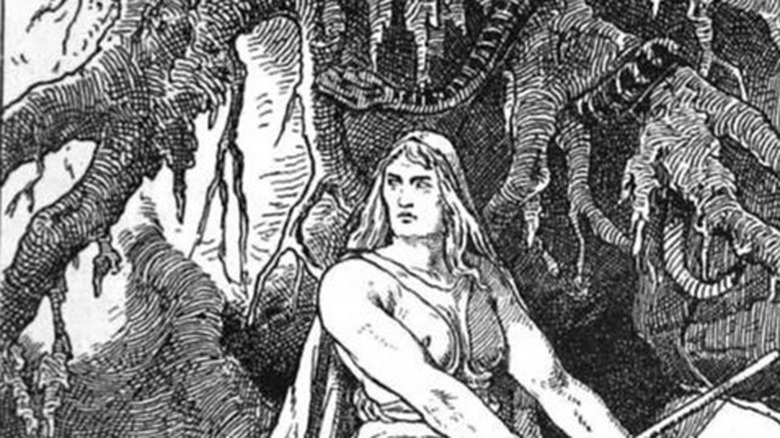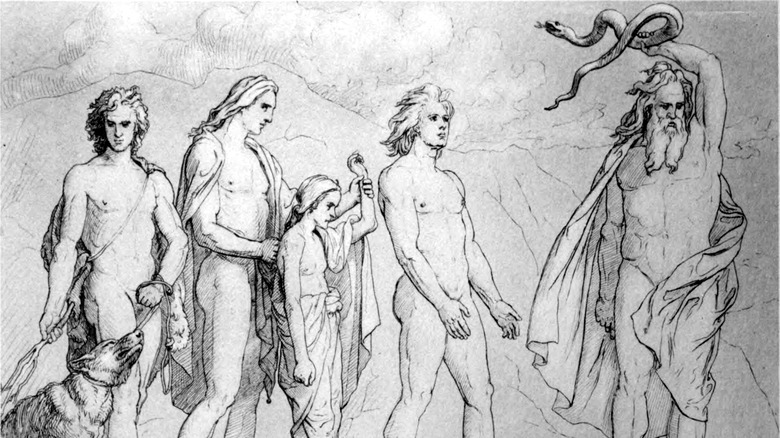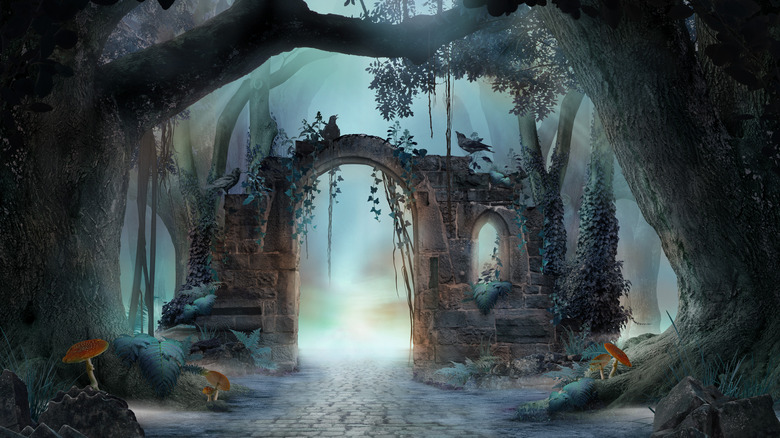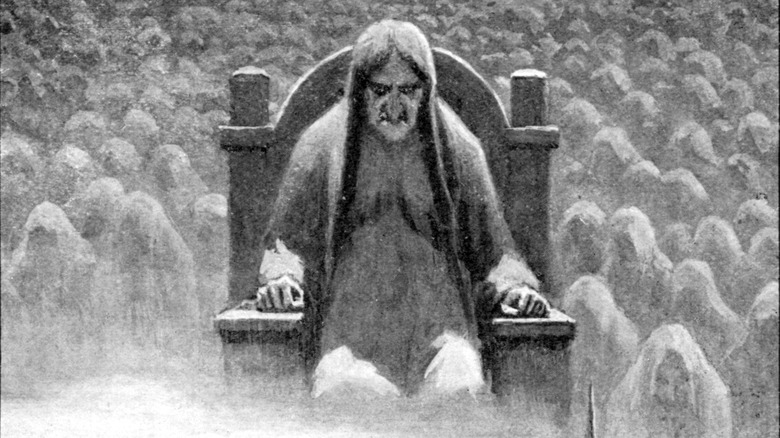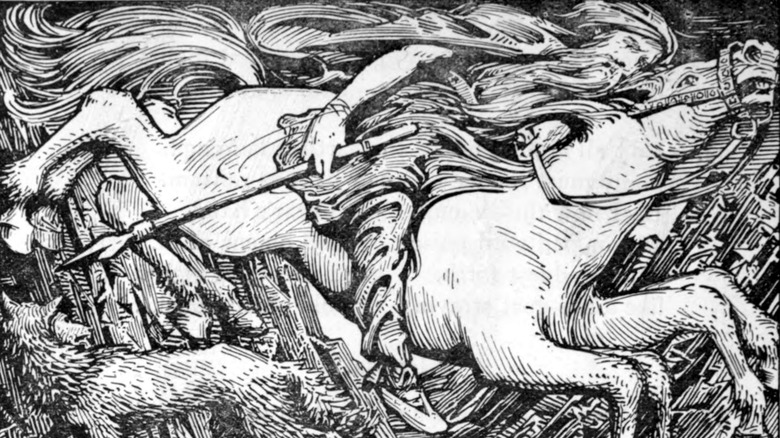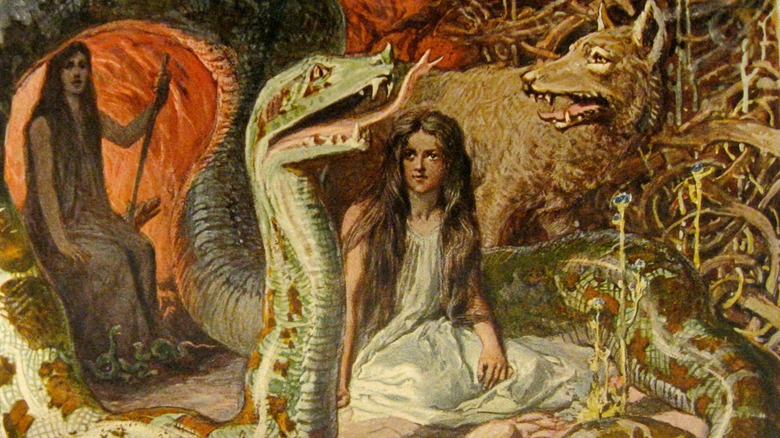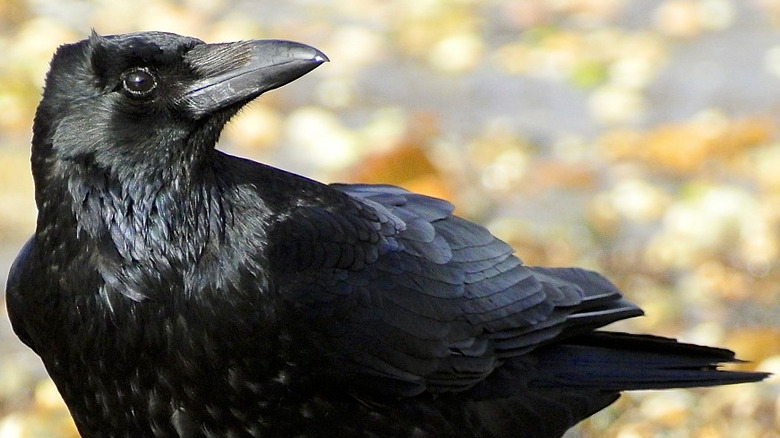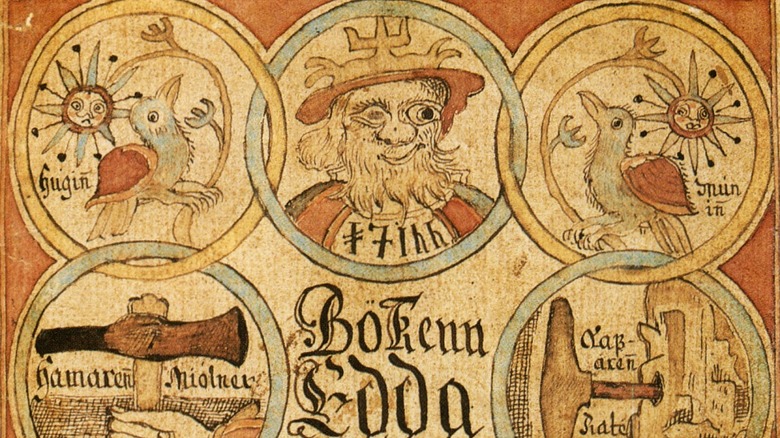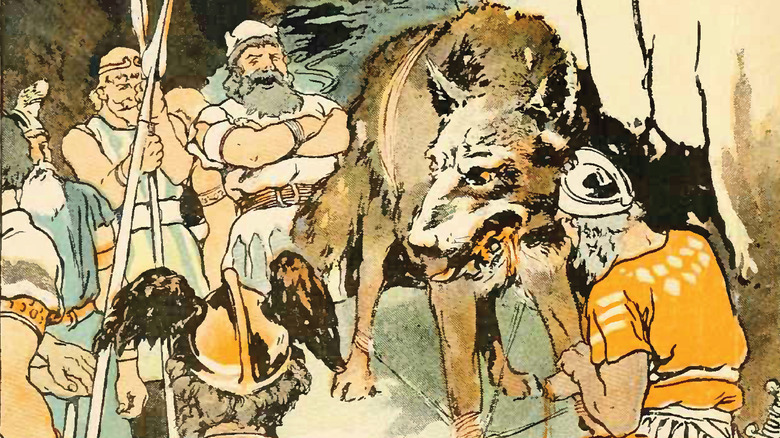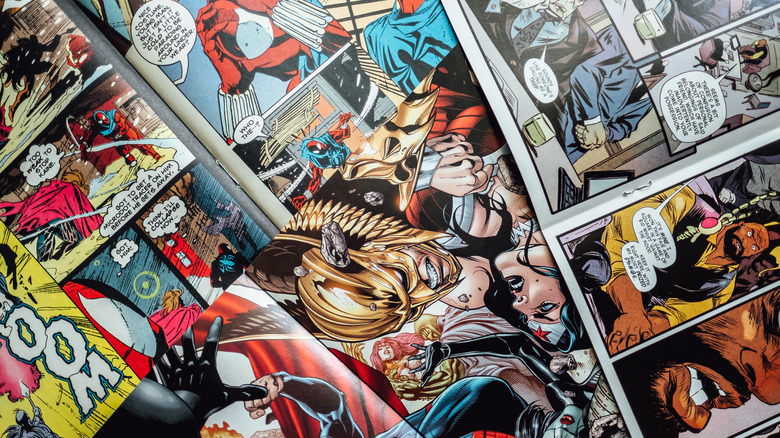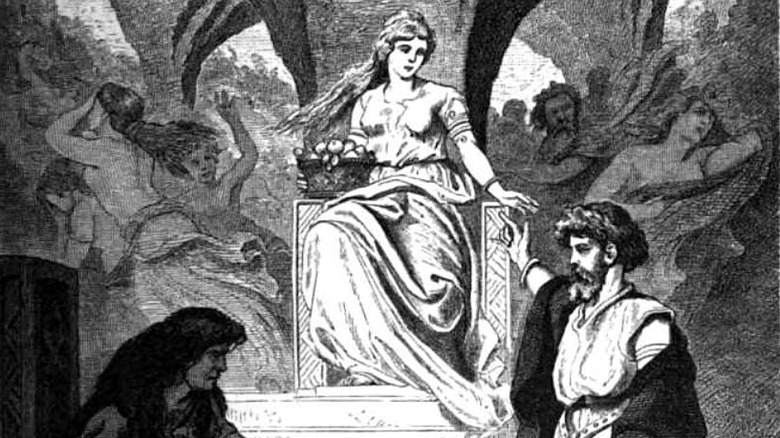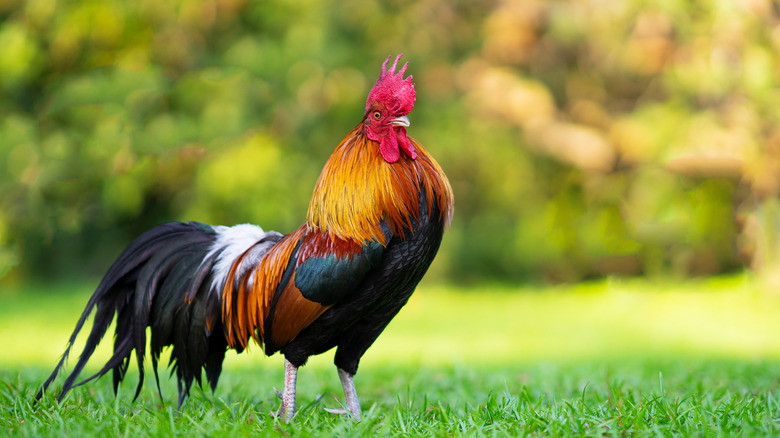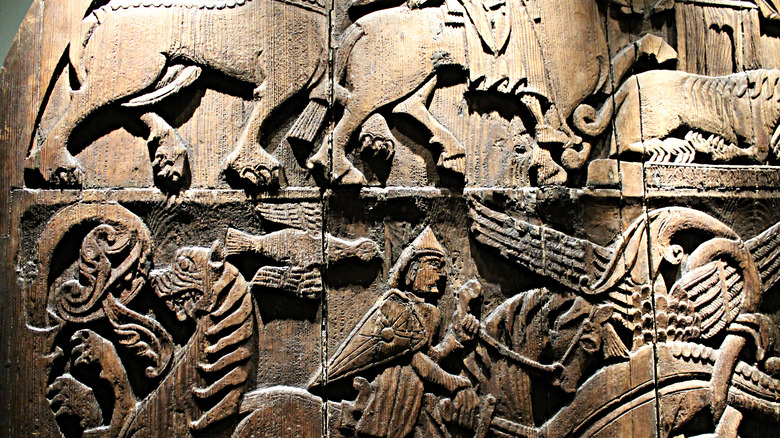The Mythology Of Hela Explained
In Norse mythology, Hela (also called Hel) ruled one of the realms of the dead, known as Helheim or Hel. Helheim was part of Niflheim, a misty, cold world underneath one of the world tree Yggdrasil's branches, writes The Norse Gods. Hela accepted the dishonorable dead in Helheim.
Hela, as you might expect of a ruler of the underworld, was known for being fierce and threatening. She had giantess blood, and therefore an unsettling appearance. But her brothers Fenris Wolf and Jörmungandr, the world serpent, were even more monstrous than she was. As a result, while they were locked away after the gods were given warnings of trouble from the siblings, Hela was only thrown into exile in Niflheim. Several gods traveled to Helheim for specific purposes throughout Norse mythology; Odin learned the prophecies of Ragnarök from a seer he revived while in Hela's realm, for example.
Despite this, Hela herself has little presence in most of the Old Norse myths, due to the lack of evidence in both writing and rituals. Nevertheless, Hela is honored both as Loki's daughter and as a goddess of death in her own right. Here's the mythology of Hela explained.
Hela's parents and youth
Hela was the daughter of Loki and his mistress, the giantess Angrboða. This made Hela the sister of the wolf Fenris and the world serpent Jörmungandr. Hela spent her youth with her brothers in Jotunheim, the land of giants. Loki and Angrboða, quite understandably, kept the existence of their children a secret for several year. When the other gods heard the news, they were — even more understandably — quite alarmed, writes Mythology Source. The fact that Angrboða was involved at all was enough to be disturbing.
Eventually, Odin decided the three children should come live in Asgard, as their father had before them. There were, however, several prophecies of doom regarding Loki's offspring. Therefore, Jörmungandr and Fenris (also known as Fenrir) were locked away to reduce the risk by Loki's children: Jörmungandr was thrown into the sea, and Fenris was locked in unbreakable chains. The gods did try to tame him for a while, but this didn't work in the end; the god Tyr sacrificed a hand while tying him up.
Hela, who looked much more human than her brothers, was only sent away. Odin did, however, fling her from the sky into Niflheim the underworld. Making the best of it, she founded Helheim and declared herself ruler.
Her realm, also named after her
Hela rules over the realm of the disreputable dead, which was also named after her and called Hel. It was a part of Niflheim, the land of cold and fog. People who died of old age, illness, or in cowardice went to her realm; on the other hand, people who died in battle went to Odin's Valhalla. Freya also oversaw an afterlife, Fólkvangr, for people who died well, though not in battle, such as women in childbirth.
Hela's name means "hidden" or "covered," which is fitting for a realm that was hidden under Yggdrasil's branches as dead bodies are underneath graves (via Norse Mythology). Helheim is located underneath the branches (or roots) of the world tree, and the dragon Nidhogg chews on them, spreading decay into the tree. Nidhogg also takes the blood from the dead, which is why they are ghostly pale (via Nordic Culture).
Helheim itself was surrounded by a fence. The river Élivágar, which had 11 tributaries (one of which was called Gjoll), flowed by the entrance, writes Nordic Culture. The entrance to Hela's realm was situated in a cave known as Gnipa, and the gates were known as Nagrindr, or corpse-gates. There Garmr (also known as Garm), a hellhound, waited to howl at new arrivals. Some think the hellhound might instead be Fenrir, Hela's brother (via Nordic Culture). If so, it would be a nice family reunion, since after their youth Hela had no relationship with her siblings, as they operated in different parts of the worlds.
Her role in the Old Norse myths
Hela has a prominent role in the death of the Nordic god Balder. Other than that, she is mostly mentioned in passing.
Balder was one of Odin's sons. His mother Frigg made sure nothing could harm him, except mistletoe, according to Mythology Source. You know where this is going: Balder was harmed with a weapon made of mistletoe, and died. During the grand funeral, Balder's wife Nanna was so overcome with grief that she too died during the service; conveniently, her body was simply added to her husband's funeral pyre.
Hermod, another of Odin's sons, was chosen as his emissary to go to Hela and convince her to allow Balder to come back to life. Balder, meanwhile, was treated as a guest by Hela, and was given good food (via Nordic Culture). Hermod borrowed Odin's steed, Sleipnir, and took nine nights to reach Helheim. Once there, he spoke to the guardian Modgunn, explaining his visit. Hermod passed over the Gjoll bridge, and spoke to Hela and Balder. He told Hela that everything wept for Balder; she replied saying she would only release him if everything in the universe literally did weep for Balder. Eventually, after much cajoling and explaining on Hermod's part, nearly everything cried for Balder's return. The only holdout was a giantess called Thokk; she was thought to be Loki in disguise. Due to Hela's condition not being met, Balder stayed in Helheim. But Loki's trickery with Balder eventually led to Ragnarök.
Hela was known to be threatening and harsh
Contrary to her two brothers, Hela still resembled a person. But that doesn't she was exactly ... normal. Hela is described as being half flesh-toned and half blue early on in Norse mythology (in the "Poetic Edda"), according to Nordic Culture and Mythology Source. Later on, her blue half changed in description to resemble a living corpse, with the bones on half her body exposed. She has also been described as looking half-white and half-black, like Greek mythology's goddess Melinoe (via Norse Mythology). Hela therefore became more monstrous and unsettling to the gods as her description changed.
Hela was known for her cruel demeanor, and is also described as being harsh, greedy, and indifferent (via Norse Mythology). She was noted for wearing a grim and fierce expression. Her uncaring role in the murder of Balder is enough of an example. Nevertheless, in the "Prose Edda" she was said to provide gifts and lodgings to her dead, especially those who had died of old age or disease (via Mythology Source).
People were unlikely to lie to Hela, since one of her eyes was made of fire and could only see the truth in things, writes Gods and Goddesses.
Hela's purported role during Ragnarök
Odin received the prophecies of Ragnarök before it took place, and Hela and Helheim were both mentioned (via Mythology Source). In the 13th century, Icelandic historian Snorri Sturluson wrote or compiled the "Prose Edda" to tell the story leading up to Ragnarök, as well as the battle and the aftermath. According to the Edda, on Ragnarök, Hela and her army of the dead will depart for a place called Vigrid on Naglfar, a ship made of human nails, according to Nordic Culture. The final battle will take place in Vigrid, where Hela will join her father Loki, who will captain the Naglfar. Her brothers Fenris and Jörmungandr will also have broken free and joined the battle. However, the actual battle itself does not have a role for Hela, implying her possible survival of the end of the world.
Ragnarök meant the end of the age of gods and the world of men. Hela's entire family would be destroyed in the process. In Sturluson's 13th century depiction of Ragnarök, he writes that new afterlives will be created, so it is possible that Hela will rule one of those in a kinder, gentler manner than before, though it will also be more Christian-influenced than before.
Hela's symbols and similarities
Hela is associated with crows, as well as her hellhound Garmr. In that sense she shares an affinity with the Greek god of the dead, Hades, since he also possessed a hellhound, Cerberus. As Hermod is similar to Orpheus, who tried to rescue someone from the underworld and failed, Hela, like Hades, also didn't allow Balder to return with Hermod to the land of the living.
As time passed, influences from Christianity and Greco-Roman mythology changed the view of Helheim into that of a physical realm with a constantly-present ruler, writes Mythology Source.
Hela is also occasionally affiliated with the rune Hagalaz (via Gods and Goddesses). Hagalaz literally means "hail" or "hailstone," writes Rune Secrets. It refers to crisis or radical change, and opportunity. Hagalaz also signifies the destructive powers of the natural world (via The House of Twigs). This could refer to Hela's youth: she underwent change by moving from Jotunheim (where she was relatively safe) to Asgard (where she was regarded with suspicion), but was able to turn the situation to her advantage when she was flung into Helheim, seizing the opportunity to create and claim a realm for herself. Hela understood both change and opportunity, which could be part of the reason Hagalaz fits her so well.
Hela might not have existed at all
Since Hela is only mentioned in passing in Old Norse texts, some historians have suggested she didn't really exist as a Norse deity, and was just a figment of the imagination for some storytellers. However, references to her do go back to the 10th or 11th century. Earlier texts discuss the realm, but not the ruler.
Icelandic scholar Snorri Sturluson practically defined her in his writing, the "Prose Edda," which is why much of what is known of Hela comes from his work. He was influenced by the growth of Christianity when he was writing in the 13th century, and added several elements meant to appease the church (via Mythology Source). Hela's realm is referenced to have punishments, and the world post-Ragnarök can seem as similar to Paradise. He also believed people who committed terrible crimes were sent to Hela's realm under a system of reward and punishment. According to Mythology Source, he is believed to have invented other characters for his work.
According to Norse Mythology, scholars also viewed Hela as a late literary personification of the grave rather than an actual worshipped goddess. What actual Vikings thought or knew about Hela is likely lost, since Sturluson was so influenced by Christianity when he was writing.
Hela's servants and associates
Hela was waited on by two servants in Helheim: Ganglati and Ganglot. They were said to move so slowly that they appeared not to move at all, writes Gods and Goddesses. Their names also refer to laziness, and it is unclear whether they were alive or dead. Even Hela's dishes and cutlery had a note of despair in them, being named "hunger" and "famine." Her sickbed had curtains which were named "misfortune."
Her hall was called Eljudnir, and Hela didn't often leave it since she couldn't travel freely; her home was situated underneath Yggdrasil's branches, after all. Her father Loki was bound after the death of Balder, and wouldn't gain his freedom again until Ragnarök, writes Mythology Source. Her brothers were similarly bound. Therefore, her only associates with her in Helheim were the dead and the few monsters who helped her, such as Nidhogg, Garmr, and the guardian Modgunn.
Modern portrayals of Hela
Hela has become famous in modern times despite her small role in Old Norse texts. The Marvel Comics villain Hela is based on the Norse Hela. She has been a frequent enemy of Thor since the Silver Age of comic books (via Marvel). Cate Blanchett portrays her in the Marvel Cinematic Universe.
"The Order of the Stick" is a webcomic that makes fun of medieval fantasy and features Hela as an antagonist who wants to destroy the world, writes Gods and Goddesses. She and Thor agreed that she could have the souls of dishonorable dwarves at the creation of the world. In response, all the dwarves became honorable, and she therefore feels cheated. If the world were destroyed, all the dwarf souls would belong to her by default.
Hela has also been portrayed in Rick Riordan's middle grade series "Magnus Chase and the Gods of Asgard," about Norse demigods who attempt to save the world, where she tries to convince Magnus to give up his quest and join his deceased family multiple times, but to no avail (via Goodreads). At the conclusion of the series, Magnus knows he will one day have to go to Helheim and confront his family and Hela, but has no plans to do so soon.
Hela's influence on the world
Hela has had most of her influence on the world centered on language. Holland and Helsinki were probably named after Hela, as were Helvetia, the female national personification of Switzerland, and Holstein. The expression "go to hell" also likely originated with Hela. The Old Norse "Hel" turned into the Old English "Hell" which further became the Indo-European "Kel;" all three words meant "hide" or "cover" (via Nordic Culture).
According to Gods and Goddesses, the Commedia dell'arte masked harlequin design could be based on Hela's appearance. Though the character is intended to be a jokester, the mask can have devilish features, according to Italy Mask. Imitation medals and bracteates (single-sided medals worn as jewelry) from the Migration Period may show Hela's likeness, preserving it for posterity. As the Viking Age falls further and further into antiquity, imitation recreations may be the best bet for physically seeing what everything looked like.
Other creatures in Hela's realm
Hela's realm holds many other creatures who have some part to play in Norse mythology. The dragon (or serpent) Nidhogg ordinarily stayed close to Niflheim's shore of corpses, which held a castle where venomous serpents faced north, and took the blood of murderers, perjurers, and adulterers there, writes Gods and Goddesses. Meanwhile, Hela's guardian Modgunn told visitors who else had died recently when they passed by her to explain their business.
Three roosters are said to crow when Ragnarök begins; one of them resides in Helheim, is "sooty red," and is the only one not named (via Mythology Source). Odin also traveled to Hela's realm to speak with a sorceress, the volva, who he had to revive to hear the Ragnarök prophecies from. She spoke about the roosters originally.
She also told Odin that "Hel" will have a part to play in Ragnarök, but it was unclear whether she spoke about the place or the goddess. The place certainly is involved, though. All of Helheim's inhabitants will rise up at the end of the world. Hela's hellhound Garmr is said to break loose at Ragnarök, and the dragon Nidhogg will also be released.
Goddess or monster?
It is unclear whether Hela received veneration, prayers, or offerings, which would indicate she was a goddess. She was not referred to as a goddess in the Eddas (via Nordic Culture). She therefore had no status among the other gods since she wasn't recognized as one. Death goddesses in other religions were given worship despite being unsettling, but in Hela's case it is simply unclear. Norse rituals were rarely written down, and archeological evidence is scant.
Her status as Angrboða and Loki's daughter also means that she was not fully divine. Loki was only half a god, while Angrboða was a full giantess. Jacob Grimm, a Norse mythology scholar, therefore believed that Hela was only half a goddess (via Gods and Goddesses).
Hela's physical appearance also became more monstrous as time passed. Eventually, half her face was described as exposed bone, while the other half was flesh-like, according to Gods and Goddesses. The Vikings were afraid of her and of Helheim. Sturluson wrote that the walls were built with worms and bones, and that there was sleet everywhere; wails could be heard constantly in Hela's realm. All that said, it will never be known whether Hela was treated as a death goddess, a personification of death, or something else entirely. She may have been fiction, a dreaded but revered goddess, or a personification of nature. Until more evidence is found, much of her role remains unknown.
